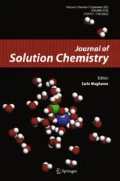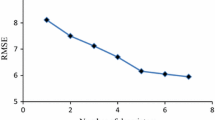Abstract
A quantitative structure-infinite dilution activity relationship was developed to predict the infinite dilution activity coefficients of halogenated hydrocarbons, γ ∞, in water at 298.15 K. A set of 1,497 zero-to three-dimentional descriptors were used for each molecule in the data set. Classification and regression tree (CART) were successfully used as a descriptor selection method. Three descriptors were selected and used as inputs for the adaptive neuro-fuzzy inference system (ANFIS). The root mean square errors for both calibration and prediction sets are 0.48. The results were compared with those obtained from other models. The results showed that CART-ANFIS can be used as a powerful model for prediction of the infinite dilution activity coefficients of halogenated hydrocarbons.






Similar content being viewed by others
References
Eckert, C.A., Sherman, S.R.: Measurement and prediction of limiting activity coefficients. Fluid Phase Equilib. 116, 333–342 (1996)
Sandler, S.I.: Infinite dilution activity coefficients in chemical, environmental and biochemical engineering. Fluid Phase Equilib. 116, 343–353 (1996)
Krummen, M., Gmehling, J.: Measurement of activity coefficients at infinite dilution in N-methyl-2-pyrrolidone and N-formylmorpholine and their mixtures with water using the dilutor technique. Fluid Phase Equilib. 215, 283–294 (2004)
Dallinga, L., Schiller, M., Gmehling, J.: Measurement of activity coefficients at infinite dilution using differential ebulliometry and non-steady-state gas–liquid chromatography. J. Chem. Eng. Data 38, 147–155 (1993)
David, W., Letcher, T.M., Ramjugernath, D., Raal, J.D.: Activity coefficients of hydrocarbon solutes at infinite dilution in the ionic liquid, 1-methyl-3-octyl-imidazolium chloride from gas–liquid chromatography. J. Chem. Thermodyn. 35, 1335–1341 (2003)
Morton, D.W., Young, C.L.: Henry’s law constants and infinite dilution activity coefficients of C2–C8 hydrocarbons in phenylalkanes. J. Chem. Thermodyn. 28, 895–904 (1996)
Gruber, D., Langenheim, D., Gmehling, J., Moollan, W.: Measurement of activity coefficients at infinite dilution using gas–liquid chromatography. 6. Results for systems exhibiting gas–liquid interface adsorption with 1-octanol. J. Chem. Eng. Data 42, 882–885 (1997)
Möllmann, C., Gmehling, J.: Measurement of activity coefficients at infinite dilution using gas–liquid chromatography. 5. Results for N-methylacetamide, N,N-dimethylacetamide, N,N-dibutylformamide, and sulfolane as stationary phases. J. Chem. Eng. Data 42, 35–40 (1997)
Dohnal, V., Ondo, D.: Refined non-steady-state gas–liquid chromatography for accurate determination of limiting activity coefficients of volatile organic compounds in water: application to C1–C5 alkanols. J. Chromatogr. A 1097, 157–164 (2005)
Trampe, D.M., Eckert, C.A.: Limiting activity coefficients from an improved differential boiling point technique. J. Chem. Eng. Data 35, 156–162 (1990)
Put, C., Perrin, Questier, F., Coomans, D., Massart, D.L., Vander Heyden, Y.: Classification and regression tree analysis for molecular descriptor selection and retention prediction in chromatographic quantitative structure–retention relationship studies. J. Chromatogr. 988, 261–276 (2003)
Breiman, L., Friedman, J.H., Olshen, R.A., Stone, C.J.: Classification and regression trees. Wadsworth, Monterey (1984)
Lavrac, N.: Selected techniques for data mining in medicine. Artif. Intell. Med. 16, 3–23 (1999)
Marshall, R.J.: The use of classification and regression trees in clinical epidemiology. J. Clin. Epidemiol. 54, 603–609 (2001)
De’Ath, G., Fabricius, K.E.: Classification and regression trees: a powerful yet simple technique for ecological data analysis. Ecology 81, 3178–3192 (2000)
Tittonell, P., Shepherd, K.D., Vanlauwe, B., Giller, K.E.: Unravelling the effects of soil and crop management on maize productivity in smallholder agricultural systems of western Kenya—an application of classification and regression tree analysis. Agric. Ecosyst. Environ. 123, 137–150 (2008)
Questier, F., Put, R., Coomans, D., Walczak, B., Vander Heyden, Y.: The use of CART and multivariate regression trees for supervised and unsupervised feature selection. Chemom. Intell. Lab. 76, 45–54 (2005)
Jalali-Heravi, M., Shahbazikhah, P.: Quantitative structure-mobility relationship study of a diverse set of organic acids using classification and regression trees and adaptive neuro-fuzzy inference systems. Electrophoresis 29, 363–374 (2008)
Atabati, M., Zarei, K., Abdinasab, E.: Classification and regression tree analysis for molecular descriptor selection and binding affinities prediction of imidazobenzodiazepines in quantitative structure-activity relationship studies. Bull. Korean Chem. Soc. 30, 2717–2722 (2009)
Zadeh, L.A.: Fuzzy sets. Inf. Control 8, 338–353 (1965)
Sugeno, M., Kang, G.T.: Structure identification of fuzzy model. Fuzzy Sets Syst. 28, 15–33 (1988)
Jang, J.-S.R.: ANFIS: adaptive-network-based fuzzy inference system. IEEE T. Syst. Man. Cybern. 23, 665–685 (1993)
He, J., Zhong, C.: A QSPR study of infinite dilution activity coefficients of organic compounds in aqueous solutions. Fluid Phase Equilib. 205, 303–316 (2003)
Li, X., Luan, F., Si, H., Hu, Z., Liu, M.: Prediction of retention times for a large set of pesticides or toxicants based on support vector machine and the heuristic method. Toxicol. Lett. 175, 136144 (2007)
Todeschini, R., Consunni, V.: Handbook of molecular descriptors. Wiley, Weinheim (2000)
Estrada, E., Diaz, G.A., Delgado, E.J.: Predicting infinite dilution activity coefficients of organic compounds in water by quantum-connectivity descriptors. J. Comput. Aided Mol. Des. 20, 539–548 (2006)
Xu, J., Zhang, H., Wang, L., Ye, W., Xu, W., Li, Z.: QSPR analysis of infinite dilution activity coefficients of chlorinated organic compounds in water. Fluid Phase Equilib. 291, 111–116 (2010)
Delgado, E.J., Alderete, J.B.: Prediction infinite dilution activity coefficients of chlorinated organic compounds in aqueous solution from quantum-chemical descriptors. J. Comput. Chem. 22, 1851–1856 (2001)
Xu, J., Wang, L., Wang, L., Zhang, H., Xu, W.: Prediction infinite dilution activity coefficients of chlorinated organic compounds in aqueous solution based on three-dimentional WHIM and GETAWAY descriptors. J. Solut. Chem. 40, 118–130 (2011)
Acknowledgments
The authors acknowledge to the Research Council of Damghan University for the support of this work.
Author information
Authors and Affiliations
Corresponding author
Rights and permissions
About this article
Cite this article
Zarei, K., Atabati, M. Prediction of Infinite Dilution Activity Coefficients of Halogenated Hydrocarbons in Water Using Classification and Regression Tree Analysis and Adaptive Neuro-Fuzzy Inference Systems. J Solution Chem 42, 516–525 (2013). https://doi.org/10.1007/s10953-013-9972-2
Received:
Accepted:
Published:
Issue Date:
DOI: https://doi.org/10.1007/s10953-013-9972-2




